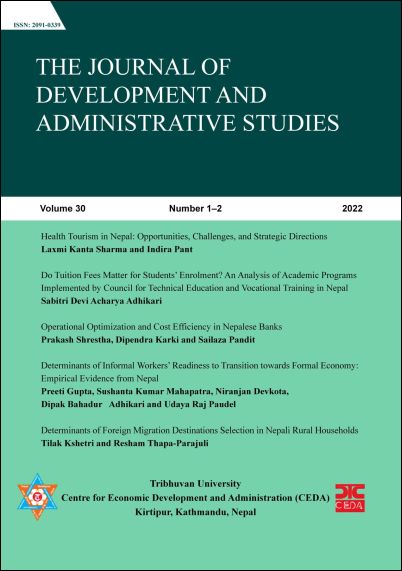Do Tuition Fees Matter for Students’ Enrolment? An Analysis of Academic Programs Implemented by Council for Technical Education and Vocational Training in Nepal
DOI:
https://doi.org/10.3126/jodas.v30i1-2.69522Keywords:
Enrolment, Tuition fees, Decision making, Econometrics modelAbstract
The amount of knowledge and skills of a country's citizens has a direct impact on its wealth and progress. The goal of the country is to increase human capital by offering technical education and vocational training to citizens. The Nepalese government prioritises the advancement of technical education and vocational training, as evidenced by budget allocations. This increasing tendency indicates a positive commitment to developing a skilled workforce. However, the challenges are in integrating the institution's increased capability with actual enrolment levels. Policymakers are faced with the challenge of resolving the gap between enrolment capacity and actual enrolment. Underutilization of the institution's capacity shows a misallocation of resources. Understanding why enrolment is low necessitates a closer examination of the hurdles. The goal of this study is to investigate the factors that influence student enrolment. Tuition fees may be the key factor determining poor enrolment in both programmes, including pre-diploma and diploma. CTEVT has paid effort to provide TVET opportunity to low income and marginalized groups. Therefore, Policymakers have dramatically expanded both constituent and private institutions throughout with increasing enrolment capacity to enhance student accessibility. Despite these excellent efforts, a significant difficulty arises for the tuition fee payment. There is considerable disparity in tuition fees among private institutions. This disparity has significant ramifications for kids and families considering enrolment. To address this issue, the research uses an economic model to determine if tuition fees influence enrolment. The findings indisputably show that tuition fees influence enrolment patterns. Higher tuition prices lead to decrease enrolment rates, whereas reduced tuition fees serve as a positive catalyst, driving higher enrolment rates. This difference has serios implication on decision making bahaviour of the students and households anticipating enrolment. Understanding this issue, the paper utilizes econometrics models to ascertain whether tuition fees serve as a determinant factor in enrolment. Higher tuition fees are associated with lower enrolment rates, while lower tuition fees act as a positive catalyst, encouraging higher rates of enrolment. The result for both pre-diploma and diploma programs unequivocally reveal that tuition fees play a key role in shaping enrolment patterns.
Downloads
Downloads
Published
How to Cite
Issue
Section
License
The copyright of the accepted articles is reserved by the Centre for Economic Development and Administration (CEDA), Tribhuvan University (TU). No part of the article published in this journal should be reproduced except provided by the law currently in force without the written consent of the centre.




